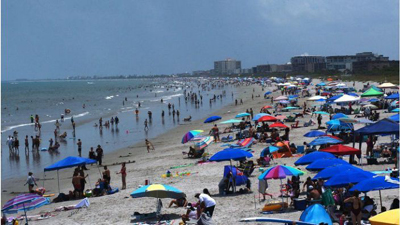

By Ritu Prasad, BBC News, Fort Myers
Florida is fast becoming America’s latest Covid-19 epicenter. The surge in the Sunshine State has been linked in part to younger Americans – but that doesn’t mean there’s no cause for concern.
Like many Covid-19 stories, it started with a dry cough.
Fever, loss of taste and chest pain followed Sanjay Bharath’s diagnosis in early March.
Mr. Bharath, who is a hospital nurse in South Florida, says he caught the virus from a patient when the Covid-19 screening process for admissions was less strict. He was told to self-quarantine two days later.
At 34-years old, Mr. Bharath does not fall into a virus-vulnerable age group. But 14 days after that first contact, he had coughed up blood and checked into the hospital.
Two days later, on 26 March, he was intubated.
“I didn’t think it was too bad,” he says, describing his first couple of hours in the ER. “I honestly thought they weren’t going to admit me at the hospital, just send me home with some sort of medication.”
As his symptoms worsened, Mr. Bharath says he would wake up in a fever-sweat every six hours, feeling chills and lightheaded and unable to catch his breath.
“I couldn’t take a big breath without coughing and choking,” he says. “It’s like you’re running a marathon constantly just by sitting down.”
Mr. Bharath would remain on a ventilator for eight days.
Short presentational grey line
Florida has been averaging nearly 10,000 new cases per day for the last week. On 12 July, the state broke the national record by reporting 15,300 cases in a single day. A Reuters analysis on 12 July found if Florida were a country, it would be fourth in the world for most new cases in a day.
As of 14 July, over 4,400 Floridians have died due to the virus and the state’s weekly average has risen to 81 people each day by local counts. The same day saw the state’s all-time highest daily death toll, with 132 reported deaths.
Florida saw the biggest daily jump in hospital admissions on 9 July, with more than 400 patients needing treatment, as well as 120 residents, including an 11-year-old girl, dying due to the virus.
Why have attitudes to face masks changed?
Critics say the number of deaths is probably higher, as Florida does not like other states report deaths suspected as having been caused by Covid-19. The state also has yet to report daily hospital admission rates, though officials have promised to do so.
Along with Texas and Arizona, the Sunshine State has fast become one of the regions with the highest surges in the country.
The positive test rate – which indicates how much the virus is spreading even with testing increases – is nearing 20%, the highest since early March when the pandemic hit the US. That’s also four times the standard for reopening set by the World Health Organization, and double the recommendation by the Centers for Disease Control.
Florida only hit the 100,000 case mark on 22 June, according to data from Johns Hopkins University. Just 13 days later, that number had doubled.
Now, there are more than 287,000 cases.
“There’s a lot of misinformation all over the web about the seriousness of this outbreak,” says Dr. Aileen Marty, a Florida International University infectious disease expert who has been working with state officials on the pandemic response. She says this is partly why Florida is now among the worst-hit regions.
“Since we don’t have a consistent message in our state, let alone our country, there’s even more confusion.”
In May and June, Governor Ron DeSantis had said reopening was feasible as cases had declined. He promised no roll-backs.
As cases began rising, Mr. DeSantis in June reversed his decision to allow bars to reopen. But he has refused to require masks statewide, though local leaders in major cities like Miami have done so, and has joined President Donald Trump in emphasising the importance of keeping the economy open.
“The way that we’ve acted after our initial lockdowns has perpetuated the problem,” Dr Marty says. “It was a failure because they didn’t do it right the first time.”
Dr Marty, who also serves as a World Health Organization adviser, says establishing a contact tracing and isolating system while the state was in lockdown was one key step that never happened.
A lack of early testing of asymptomatic individuals plus weeks of civil unrest, between anti-lockdown protesters and marches against racial inequality, have also worsened the situation.
But even as Florida’s numbers continue to trend upwards, Mr. DeSantis said last week he felt the state’s numbers had stabilized, telling residents: “There’s no need to be fearful.”





Be the first to comment